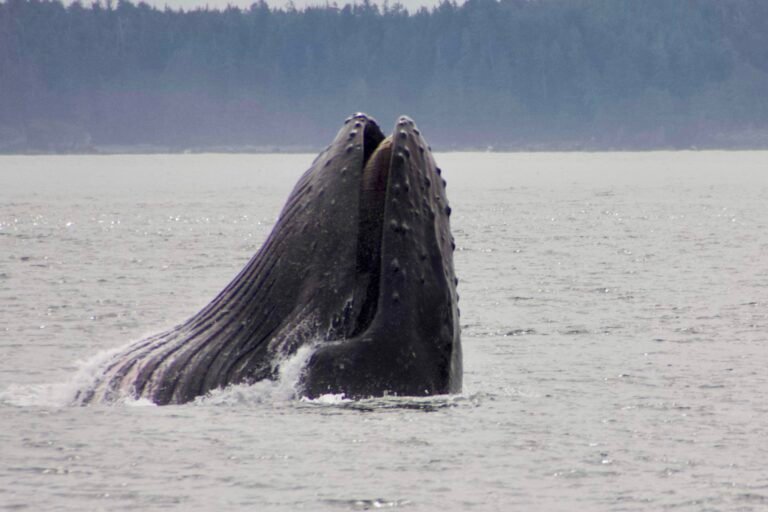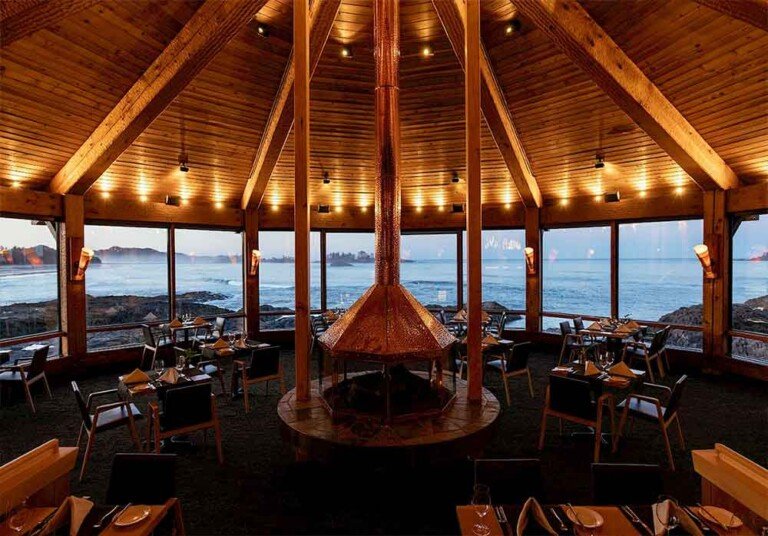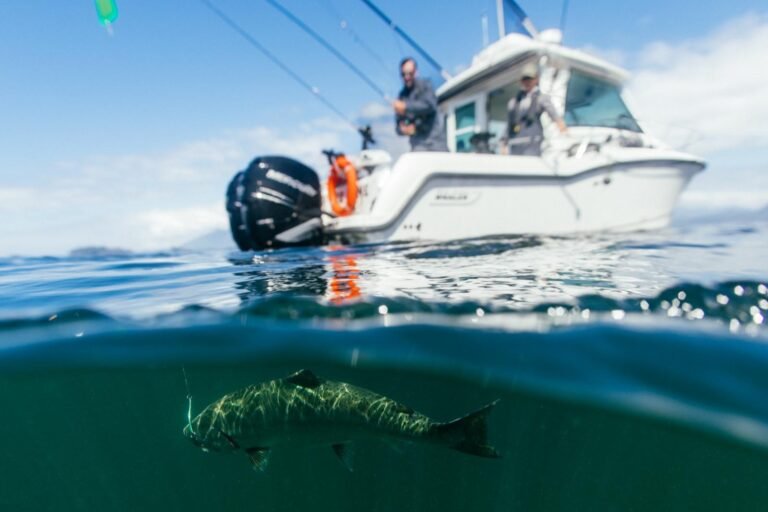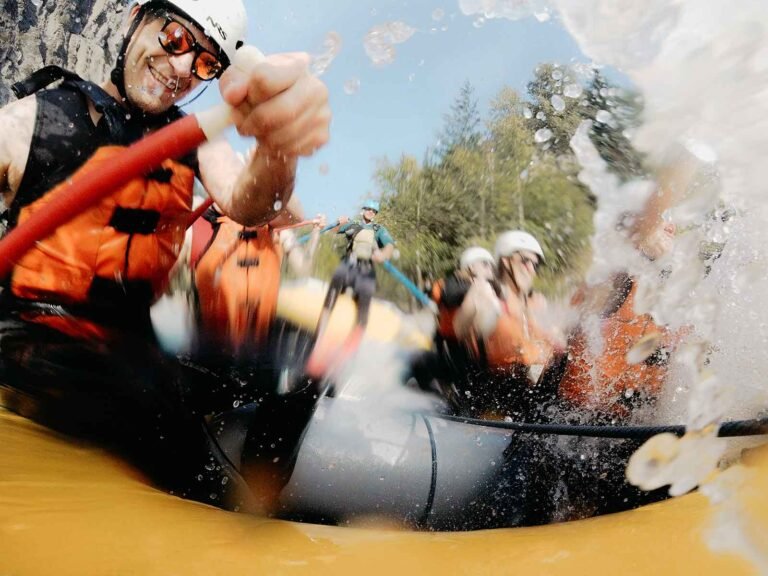The linchpin between the Yellowhead and Alaska Highways, the Stewart-Cassiar Highway is the only road that delivers adventurers to this awe-inspiring wilderness. Sections are still unpaved, and services are few. Be prepared for any eventuality, including encounters with passing bears and other wildlife.
As you travel the Yellowhead Highway (Hwy 16) west from Prince George, the fourth largest city in British Columbia, you’ll pass through Burns Lake, a diminutive freshwater fishing paradise.
With almost twenty lakes nearby, this is the place for fishing, canoeing, hiking, trail riding and exploring. Between Houston and Smithers, the magnificent mountains of the Babine and Hazelton Range, and the sheer pyramid of Mount Roche Deboule, makes this truly one of the most scenic areas in the province.

Turn north onto the Stewart-Cassiar Highway (Hwy 37) and follow a well-marked circuit in the Hazelton Valley called the Trail of the Totems Tour. First, stop to view the ceremonial poles in the village of Kitwanga, one of several locations in the Hazelton region where such poles are situated. The dozen poles here face the Skeena River, beside a century-old wooden bell tower and church. The weathered poles are carved with an array of animal and humanlike images.
Then head north along the Cassiar Highway (Hwy 37) to the small village of Kitwancool to see what are reputed to be the oldest and finest examples of totem poles in BC. Here are more than 20 poles, some old, but also a trio of more recent ones. All are intricately carved and very thought provoking. Some of the tallest poles have been left uncarved on their top halves and are surmounted by images of ravens, bears, eagles, wolves, or humans. Nearby, a shed houses some of the oldest poles, which have been laid to rest. They are beautifully weathered, almost beyond recognition, with just an eye or a beak left to suggest the original design. The three newer poles mounted together directly in front of the Gitanyow Band Council office are among the most intricately designed ones of the whole group, and demonstrate that the carving tradition here is stronger than ever.
Stop again, this time at Kitseguecla, a small Skeena River settlement near Hazelton, to see their two poles, which are as wonderfully unique as any in the region. Large sculptures grace the front yards of several homes in the community. Drive slowly and smile – you’re part of their view.
End the Totem Tour with a quick detour through Hazelton and Kispiox. Pull into the ‘Ksan Historical Village and Museum in Hazelton. The village was originally called the Skeena Treasure House, and with good reason, judging from its rich display of totems, jewellery, and clothing. A museum in one of the long houses honours the Gitksan ancestors, who were graced with such abundance that they had time to beautify the items they carved for everyday use. Seven lovingly decorated long houses are grouped together here at the confluence of the Skeena and Bulkley Rivers. Several of the long houses are open to visitors, while guided tours are offered of the Fireweed, Wolf, and Frog clan houses.
The Kispiox ceremonial poles are the most animated of all, with carved tears dripping off the faces of some figures whose eyes are inlaid with abalone. On one pole, a human character holds a grease bowl in its arms, a reminder that not only is this a modern-day trail, but also that it was once part of a coastal ‘grease trail’ along which highly valued fish grease obtained from eulachon was transported from the coast to the Interior. The eulachon is a sardine-sized fish whose body contains such a high percentage of oil that it burns like a torch when dried. The views of the Skeena River from here are staggering. Kispiox is built on high ground, about 18 miles (30 km) north of Hazelton on a paved side road. Its 18 poles have the appearance of being held in the palm of the Creator.
Back on Highway 37, you’re heading into the kind of wilderness that’s made the north famous. Mount Edziza Provincial Park and Spatsizi Plateau Wilderness Provincial Park are home to hundreds of animal species. The Spatsizi Plateau is one of the most important habitats for woodland caribou in British Columbia, while both parks support a variety of wildlife, including moose, grizzly and black bears, wolves, beavers, hoary marmots, and more than 140 species of birds, including gyrfalcons. The village of Iskut is the nearest community. Just north of Iskut you’ll drive through a 70-km stretch of the spectacular Stikine River Provincial Park.
Stop and fill up at Dease Lake before continuing north through Cassiar country. A worthwhile side trip from Dease Lake is a drive to the beautiful little community of Telegraph Creek, and the opportunity for a river boat trip or tour on the Stikine River. Located on a terrace overlooking the Stikine River, one can step back in time in the Yukon Gold Rush town of Telegraph Creek, which gets its name from an overland telegraph line to the Yukon.
Once you reach the Alaska Highway, those who must find the real edge can travel west through the extreme northwestern corner of the province to Atlin. Along the way it runs alongside the immense, uninhabited wilderness of the Tatshenshini-Alsek Provincial Park, which is in turn bordered on the north by Yukon’s Kluane National Park and on the south by Alaska’s Glacier Bay National Park. Up here, it’s a tight little world of parks – the far northwest offers explorers huge areas of unspoiled wilderness.
Nature, it seems, conspires to keep this region a secret, but for those who are prepared, the Stewart-Cassiar Highway supplies unimaginably rich rewards. A handful of wilderness parks – Mount Edziza, Spatsizi Plateau, Tatlatui, Atlin, and Tatshenshini-Alsek, cover some of the toughest territory on the continent. Getting off the beaten path, even as meagre a one as Highway 37 is a must for explorers; many areas can be reached only be foot, horseback, helicopter, or floatplane. Those seeking solitude can go for days or weeks in some areas without sharing this rugged beauty with anyone else. Forged in fire, carved with ice, coloured with sprawling verdant forests, crystalline blue lakes, and fragile alpine meadows; welcome to the backcountry.
Continue south on the Alaska Highway (Hwy 97) to Liard Hot Springs. Even in the depths of winter, which lasts eight months here, the springs are hot enough to provide relief to weary adventurers. Your next stop should be Muncho Lake Provincial Park. Muncho Lake displays a perpetually blue hue, the result of copper oxides leached from the bedrock. A little farther along the highway is Stone Mountain Provincial Park. The defining features of the park are the mountains; great humps of raw stone rising from the valleys below, where only the barest plant life survives. You wouldn’t expect to find much in the way of wildlife here, and in truth, you won’t find much on the bare slopes. But the valleys are a different matter. Mountain caribou and Stone sheep winter in some of the lower valleys, and mountain goats, moose and grizzly and black bears also frequent the valleys. A number of bird species live in the park, none more magnificent than the golden eagle. Enjoy the rich and varied wilderness, a place where people are scarce, but the exploits plentiful.
Next stop is Fort Nelson, this is deep wilderness and offers true outdoor enthusiasts some of the most pristine areas in this part of the province. The jewel of this area is Kwadacha Wilderness Provincial Park. No access by road, but guided hiking and horseback riding can be arranged. Fort Nelson is a friendly town initially founded during the fur trade. Don’t miss the superb Fort Nelson Museum, showcasing the construction era of the Alaska Highway. From Fort St. John, a busy modern city that popped up as the oil and gas industries in this region expanded, you’ll arrive in Peace River Country. Visit the community of Hudson’s Hope, know as the Land of Dinosaurs, this area is where dinosaur tracks were first discovered in North America. Return south on Highway 97 to Prince George. Interesting stops visitors won’t want to miss include the breathtaking Bijoux Falls, and the mammoth engineering feat of the W.A.C. Bennet Dam. Or visit the vintage railway collections at the Prince George Railway & Forestry Museum, and tour Huble Homestead, a fully-restored early 1900s homestead and trading post.
Approximate Distance: 2,000 Km
Approximate Duration: 7 to 14 days
Towns on or near this Route





